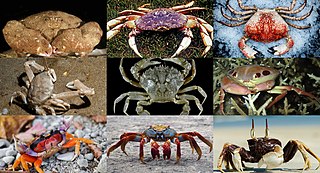
Crabs are decapod crustaceans of the infraorder Brachyura, which typically have a very short projecting tail-like abdomen, usually hidden entirely under the thorax. They live in all the world's oceans, in freshwater, and on land. They are generally covered with a thick exoskeleton. They generally have five pairs of legs, and they have pincer claws on the ends of the frontmost pair. They first appeared during the Jurassic period, around 200 million years ago.

Hermit crabs are anomuran decapod crustaceans of the superfamily Paguroidea that have adapted to occupy empty scavenged mollusc shells to protect their fragile exoskeletons. There are over 800 species of hermit crab, most of which possess an asymmetric abdomen concealed by a snug-fitting shell. Hermit crabs' soft (non-calcified) abdominal exoskeleton means they must occupy shelter produced by other organisms or risk being defenseless.

Stenorhynchus is a genus of marine crabs in the family Inachidae, containing the following species:

Parathranites is a genus of crabs. It contains the following species:
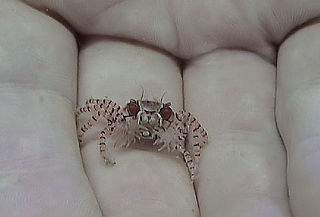
Lybia is a genus of small crabs in the family Xanthidae. Their common names include boxer crabs, boxing crabs and pom-pom crabs. They are notable for their mutualism with sea anemones, which they hold in their claws for defense. In return, the anemones get carried around, which may enable them to capture more food particles with their tentacles. Boxer crabs use at least three species of anemones, including Bundeopsis spp. and Triactis producta. The bonding with the anemone is not needed for survival, however, and boxer crabs have frequently been known to live without them, sometimes substituting other organisms such as sponges and corals for the sea anemones.
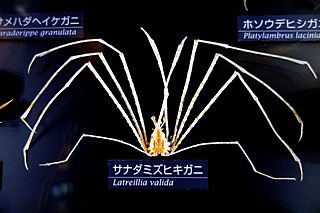
Latreillia is a genus of crabs in the family Latreilliidae, comprising five species:
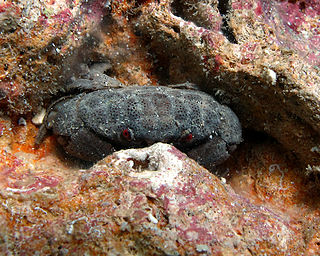
Actaeodes is a genus of crabs in the family Xanthidae, containing the following species:

Epiactaea is a genus of crabs in the family Xanthidae, containing the following species:

Novactaea is a genus of crabs in the family Xanthidae, containing the following species:
Paraetisus globulus is a species of crab in the family Xanthidae, the only species in the genus Paraetisus. It was described in 1933 by Charles Melbourne Ward.
Allactaea lithostrota is a species of crabs in the family Xanthidae, the only species in the genus Allactaea.
Epiactaeodes is a genus of crabs in the family Xanthidae, containing the following species:
Lobiactaea lobipes is a species of crabs in the family Xanthidae, the only species in the genus Lobiactaea.

Meractaea is a genus of crabs in the family Xanthidae, containing the following species:
Odhnea is a genus of crabs in the family Xanthidae, containing the following species:
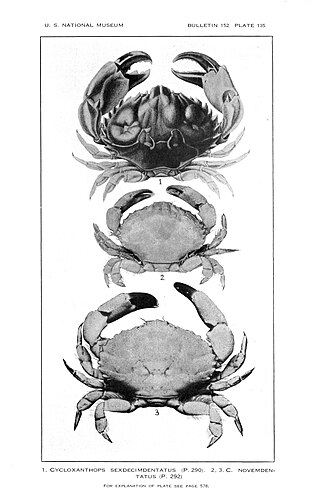
Cycloxanthops is a genus of crabs in the family Xanthidae, containing the following species:

Nectopanope rhodobaphes is a species of crabs in the family Euryplacidae, the only species in the genus Nectopanope.

Xanthias is a genus of crabs in the family Xanthidae, containing two exclusively fossil species and the following extant species:

Xanthodius is a genus of crabs in the family Xanthidae, containing one exclusively fossil species and the following species:
Calvactaea tumida is a species of crabs in the family Xanthidae, the only species in the genus Calvactaea.














